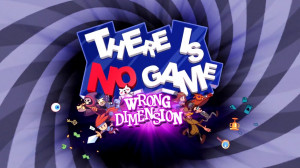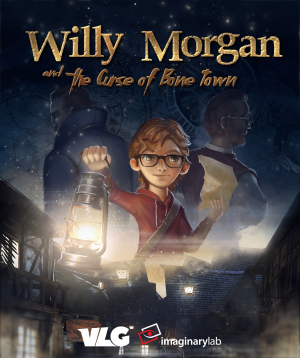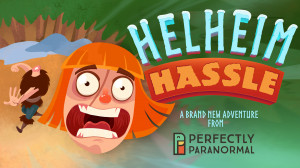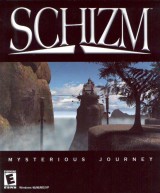Review for There Is No Game: Wrong Dimension

We’ve all had it happen: stuck on a tricky puzzle, you come up with a solution that makes perfect sense. Given everything you have on hand, it absolutely ought to work—but when you try it out you’re told, with no justification, that it doesn’t. You want to throw a rock to knock that beehive down? Well, too bad. You can’t interact with a single one of the rocks scattered around your screen, because the game wants you to lure a woodpecker over and have it drain the honey into a teacup. No, it doesn’t make any sense, but that’s the game, and you have to play by its rules if you want to reach the end. It’s frustrating, because part of what’s supposed to make an adventure game special is the feeling of being dropped into a situation and forced to think your way out. At their best, games have the ability to make you feel like you’re driving the experience, not being driven; consistent failure to do that will leave you wishing you could reach inside the game and make it work the way it should. Why play by the rules, after all, if the rules just make the game worse? Alas, that’s how the medium works: no matter how open a game’s world, how reactive its AI, or how procedural its generation, you can only ever do as much as the developers thought to program.
But what if you didn’t have to? What if you could brush past a developer’s “because I say so,” slicing through the Gordian knot of unintuitive design to impose your own brand of order when a game won’t cooperate? There Is No Game: Wrong Dimension is a joyfully anarchic exploration of what that kind of power might be like, gleefully thumbing its nose at the mustiest conventions and celebrating the nigh-unlimited potential that an interactive medium ought to possess. It’s an inventive, hilarious, anything-goes experience that asks you to rethink everything you believe about what games can be.
There Is No Game started out in 2015 as a fifteen-minute Flash title. The premise was simple: it absolutely didn’t want you to play it, or even to recognize that it could be played. At each step, developer Pascal Cammisotto’s gruff, French-accented voice informed you that you were wasting your time, there was nothing to do here, and for everyone’s sake you should just move on and use your time more productively. Your task was to ignore these increasingly flustered protests and push on to uncover the gameplay it was so clearly hiding from you. There were only a few screens, but its offbeat premise, amusing presentation, and outside-the-box puzzles helped it grow into a cult favorite. A Kickstarter campaign to bankroll a full-length version failed to reach its funding goal the following year, but Cammisotto wasn’t deterred; he spent the next four years putting the game together himself under the studio banner of Draw Me A Pixel, finally releasing commercially in 2020 with its current title.
Wrong Dimension starts out much like its freeware predecessor, with the game, again voiced by Cammisotto, making every effort to prevent you from recognizing it as such. (The voice belongs not to a discrete narrator but to the game itself. To make things easier, I’ll capitalize it when discussing it as a character—“the Game”—and use lower case to refer to the program itself.) It hits the ground running: the opening menu features an oversized “Quit” button surrounded by flashing lights and brightly colored arrows opposite a drab, unremarkable tab marked “Play.” Selecting the latter will take you to a loading screen bearing the image of a disk and the message “When this icon appears, exit the program immediately to maximize your chances of corrupting your autosave. Thank you.” The Game’s determination to keep you out only increases from there as it continually tries—politely at first, but rising in fervor as you refuse to take the hint—to barricade all traces of interactivity behind increasingly impenetrable obstacles; the more persistent you are in sticking around, the harder the Game strives to drive you away.
It’s hard to review something whose entire M.O. is the confounding of expectations. There Is No Game: Wrong Dimension is full of audacious, unconventional and flat-out bizarre features that absolutely shouldn’t work, but do. Any one of them would be worth the price of admission, and I’d love to describe them to you, but to tell you they were coming would be to rob them of what makes them special. Suffice it to say that an encounter with a malicious programming bug—voiced again by Cammisotto, who’s clearly having the time of his life in his dual roles—forces you and the Game to make common cause, launching you on an odyssey through the inner workings of various gaming genres, including arcade titles, RPGs, and point-and-click classics, among many others. (The presence of an actual story is one of the many ways Wrong Dimension differs from its bite-sized predecessor; as with just about everything else here, Cammisotto pulls this off in ways I never would have expected.)
Each of these segments features its respective genre at its most archetypal, with all the attendant quirks and shortcomings that entails. Your objective is never to play them as they were designed, but to examine and find ways to manipulate the frameworks in which they exist; any rules that come up are yours to bend, break or circumvent. Screens aren’t treated as living areas full of flesh-and-blood characters with whom you’re interacting, but rather stages populated by props, actors and scenery, all of which you can re-dress, manipulate and/or disassemble as necessary.
The art style changes to match each new variety of game you encounter, and each iteration perfectly mimics the real-life titles that Wrong Dimension seeks to evoke, including a top-down, pixel-heavy approach a la The Legend of Zelda and a downright astonishing imitation of Larry Ahern’s style from Sam & Max and Day of the Tentacle. The soundtrack, too, is constantly transforming to match new developments, ranging from gentle, synthesized versions of classical standards to imitation chiptunes to an unhinged battle-rap-inspired number that should not under any circumstances succeed as well as it does.
Despite the numerous genres and play styles you’ll explore and inhabit, Wrong Dimension is an adventure through and through. Many of the puzzles come closest to what you might call “inventory-based,” in the sense that you’ll frequently find, use and combine objects to overcome obstacles, but the definition of an “item” here is expanded so far outward that it takes on an entirely new character. If you can interact with something on screen, odds are you can find a way to pick it up or use it—and that includes icons, menu buttons, text, and other parts of the interface. Where a traditional adventure might make you build a boat or find a raft to ford a river, for instance, in this game you could simply grab a character’s dialogue box to use as a bridge.
Your progress depends on being able to recontextualize everything you see as a part of your field of play. It’s less important what something is than what it looks like, where it’s located, and what might happen if it was moved. This leads to some audaciously unconventional puzzles with hilariously unhinged and meta-referential solutions, though they’re never so random that you won’t have at least a sense of what you should be doing. Again and again, Wrong Dimension produces situations where you’re just about to get frustrated at a solution that isn’t working, only to suddenly realize how the pieces fit together with elements that were hiding in plain sight the whole time. It’s such a pleasure to finally figure a puzzle out that the Game’s tendency to chime in with gentle hints started to annoy me; often these were more blatant than I would have liked, and more than once they arrived before I’d had a real chance to properly consider what to do. If there’s a way to change the hint frequency I never found it, though they did seem to slow as I got further along.
You control everything with a circular blue cursor that glows and enlarges over hotspots, and changes into a hand to signal that you can pick something up. This simple setup remains consistent across the many various gameplay permutations you encounter; considering how many different ways you’ll actually play in Wrong Dimension, it proves surprisingly versatile. Picking up an item—or detaching an element from the interface, as the case may be—causes it to fall to the bottom of the screen, with the resulting pile serving as your inventory. There are no verbs or commands; you interact with the environment directly using your cursor or the objects you collect. When new functions creep in, as they do from time to time, the Game will tell you what you need to know in order to use them. Your progress is automatically recorded, but you can also save manually whenever you quit.
Even without such top-notch puzzle design, the writing would make Wrong Dimension worth playing on its own. It’s laugh-out-loud funny on a more consistent and frequent basis than anything I’ve played in years; the few jokes that don’t land—like a tired-but-mostly-inoffensive segment featuring programs from various countries—are quickly buried by ten more that do. More than that, the writing is smart; it knows how to engage with its forebears, its own legacy, and with the history of video games in general without relying on hollow name-dropping. The game is littered with knowing asides about its own troubled production (crowdfunding is a sore subject for the Game), the various genres that spawned it, and the players who made the original Flash game a success. (Many apparently assumed, based on his accent, that the French Cammisotto was Russian; this misconception is repeatedly referenced here, much to the Game’s chagrin.) The story is engaging and well-constructed; no matter how bizarre, unexpected or from-left-field a new development may be, it always makes its own kind of sense.
Considering the Game itself is your constant companion, much of the enjoyment hinges on how well it’s portrayed; thankfully it’s a delight as a character. The more time you spend in its bemused and often-exasperated company, the more you’ll begin to see of its surprisingly complex personality. Its constant disbelief and frustration at your rule-breaking is unceasingly amusing, but the glimpses you get into its interior world reveal an unexpected emotional depth. Much credit is due to Cammisotto’s expressive performance in the role; his rumbling baritone, unique delivery and distinctive accent lend a broad range of personality to a character who by definition lacks a face or body to emote with. The voice acting is all so excellent and effective, it’s hard to imagine Wrong Dimension working as well as it does with anyone else in the central role.
I could go on for a very long time about everything that works in There Is No Game: Wrong Dimension, but I’ve said just about all I can to an audience that hasn’t played it. Even if I could say more, I doubt it would do justice to a game that simultaneously reinvents, subverts and celebrates everything worth loving about adventures and video gaming. I was shocked when the credits rolled to realize that the experience had only lasted around six hours; with so much to do and see I felt like I’d been playing for much longer. It’s an unqualified success on just about every level imaginable; to understand why, I can only recommend letting it speak for itself.
Our Verdict:
There Is No Game: Wrong Dimension takes the rulebook for what a game can and should do and sets it on fire, practically reinventing the entire medium in the process. Unceasingly hilarious, ludicrously entertaining, and utterly unique, it will remind you why you play games while forcing you to reconsider every aspect of what that means.





























